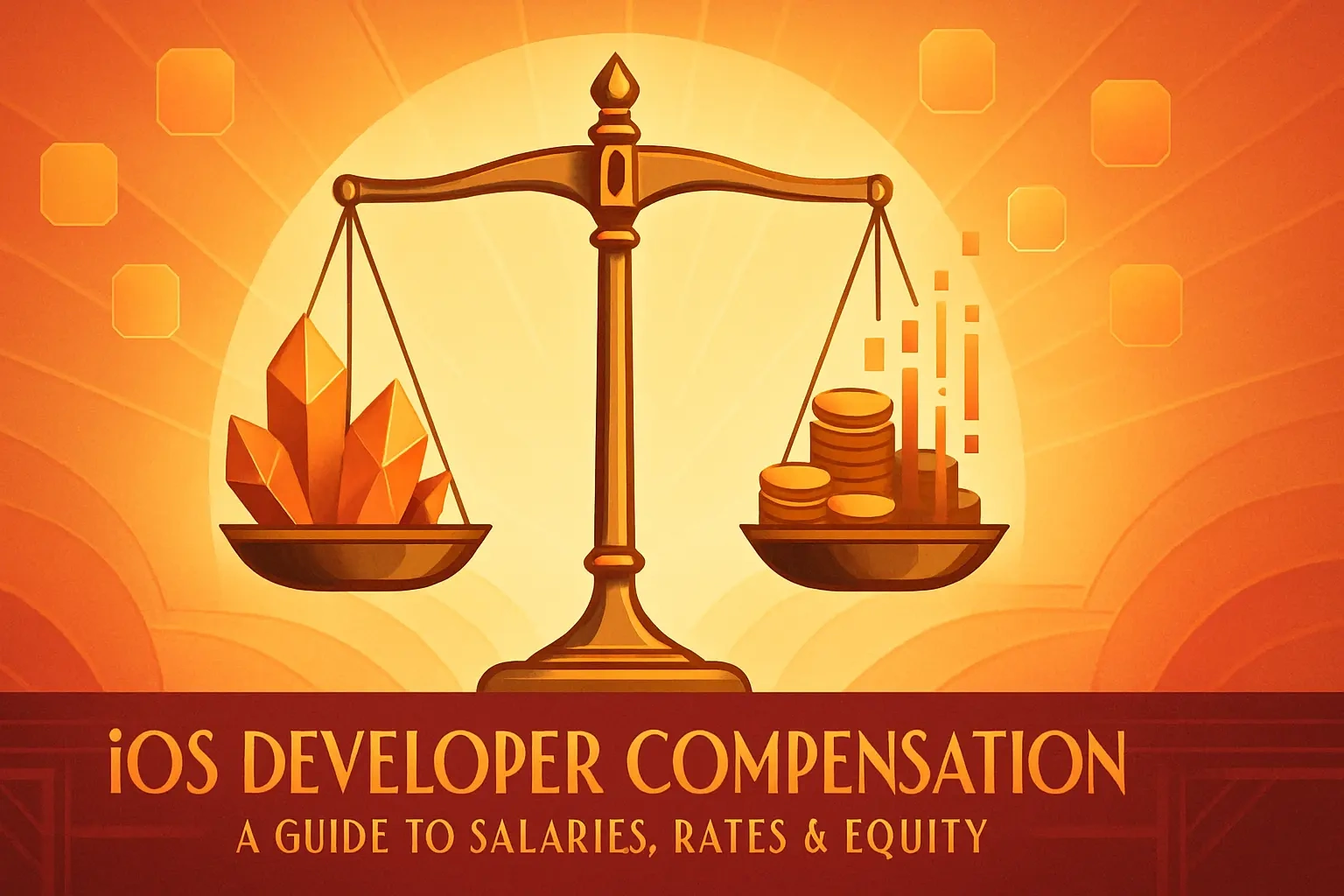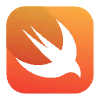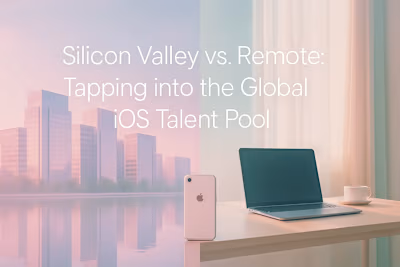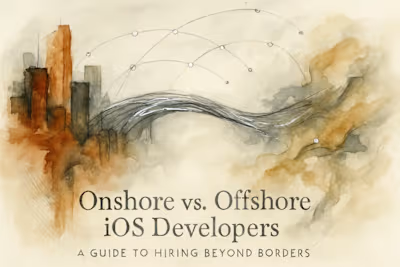iOS Developer Compensation: A Guide to Salaries, Rates & Equity

iOS Developer Compensation: A Guide to Salaries, Rates & Equity
Benchmarking iOS Developer Salaries in 2025
Salary by Experience Level
Impact of Location on Salary
In-Demand Skills that Boost Pay
Navigating Freelance iOS Developer Rates
Average Hourly Rates
Project-Based vs. Hourly Pay
Leveraging Equity to Attract Top Talent
Structuring an Employee Stock Option Pool (ESOP)
Vesting Schedules Explained
Determining Equity Grants for Different Roles
Total Compensation: Looking Beyond the Numbers
The Value of Benefits
Perks that Make a Difference
References
iOS Developer Compensation: A Guide to Salaries, Rates & Equity
Determining the right compensation for an iOS developer is one of the most critical steps in the hiring process. A competitive and well-structured package is key to attracting and retaining top-tier talent. Whether you're hiring a full-time employee or a freelancer, understanding the market rates is essential. This guide will help you navigate the complexities of developer pay, from typical salaries based on experience to freelance hourly rates. We will also explore how to effectively use equity as a powerful incentive.
Getting this right is a crucial part of making a compelling offer and ensures you can find the right iOS developer for your team without over- or under-paying. It also lays the groundwork for clear legal and contractual agreements.
Benchmarking iOS Developer Salaries in 2025
Salaries for iOS developers can vary significantly based on experience, location, and specific skill sets. Understanding the current market benchmarks is the first step to creating a competitive offer.
The iOS development market has evolved dramatically over the past few years. With Apple's continued dominance in the mobile space and the growing complexity of iOS applications, skilled developers command premium salaries. Companies across industries are competing for the same talent pool, making it crucial to understand what constitutes a competitive offer.
Salary by Experience Level
Compensation grows with experience. An entry-level developer (0-1 years) might expect around $97,000, while a junior developer (1-3 years) earns about $112,000. Mid-level (4-6 years) and senior developers (7+ years) command higher salaries, averaging $129,000 and $141,000+ respectively.
But these numbers tell only part of the story. Entry-level developers fresh out of bootcamps or computer science programs bring enthusiasm and current knowledge of the latest iOS frameworks. They're eager to prove themselves and often adapt quickly to your team's coding standards. While they need mentorship, they can handle straightforward feature development and bug fixes effectively.
Junior developers have weathered their first real-world projects. They've learned from mistakes and understand the importance of clean code and proper testing. At this stage, they can work independently on moderate complexity features and contribute meaningfully to code reviews.
Mid-level developers represent the sweet spot for many teams. They've built complete apps from scratch, dealt with App Store rejections, and understand the nuances of iOS development. These developers can architect new features, mentor juniors, and make critical technical decisions. Their salary reflects this increased responsibility and reduced supervision needs.
Senior developers bring deep expertise and leadership. They've seen multiple iOS versions come and go, adapted to major framework changes, and developed strong opinions about best practices. Beyond coding, they shape technical strategy, establish development standards, and often serve as the bridge between engineering and product teams. Their compensation reflects not just their coding ability but their strategic value to the organization.
Impact of Location on Salary
Geographic location plays a major role in salary expectations due to differences in cost of living and tech industry concentration. For example, developers in major tech hubs like San Francisco or New York City typically earn more than those in other regions.
San Francisco Bay Area salaries often run 20-30% higher than the national average. A mid-level developer earning $129,000 nationally might command $155,000 or more in San Francisco. New York City follows closely behind, with salaries typically 15-25% above average. Seattle, Austin, and Boston also offer premium compensation, though slightly below the Bay Area levels.
But the remote work revolution has complicated this picture. Many companies now offer location-adjusted salaries, creating tiers based on cost of living. A developer in Denver might earn 90% of a San Francisco salary, while someone in Kansas City might receive 75-80%. This approach balances fairness with fiscal responsibility.
Some forward-thinking companies have adopted location-agnostic pay scales. They argue that the value a developer brings doesn't change based on their zip code. This strategy can be particularly effective for attracting top talent from lower-cost areas who might otherwise be priced out of consideration.
International hiring adds another dimension. Skilled iOS developers in Eastern Europe, Latin America, or Southeast Asia often accept salaries 40-60% lower than US rates while delivering comparable quality. However, time zone differences, communication challenges, and legal complexities must be factored into the total cost calculation.
In-Demand Skills that Boost Pay
Proficiency in specific technologies can increase a developer's market value. Expertise in Swift and Objective-C is fundamental, but skills in areas like SwiftUI, Combine, and experience with various API integrations can lead to higher salary offers.
SwiftUI expertise has become particularly valuable as Apple pushes this declarative framework. Developers who can build complex, responsive interfaces with SwiftUI often command 10-15% salary premiums. The framework's relative newness means experienced practitioners are still scarce.
Combine framework knowledge signals a developer who understands reactive programming and can build sophisticated data flows. This skill becomes crucial for apps dealing with real-time data, complex state management, or intricate user interactions.
API integration experience goes beyond basic REST calls. Developers who've wrestled with GraphQL implementations, handled complex authentication flows, or integrated with finicky third-party SDKs bring battle-tested knowledge. They can estimate integration timelines accurately and avoid common pitfalls.
Performance optimization skills separate good developers from great ones. Those who can profile apps, identify bottlenecks, and implement solutions command premium rates. This includes understanding Core Data optimization, image caching strategies, and memory management nuances.
Accessibility expertise has moved from nice-to-have to essential. Developers who can build truly accessible apps that work seamlessly with VoiceOver and other assistive technologies are increasingly valuable. This skill demonstrates attention to detail and commitment to inclusive design.
Cross-platform experience, particularly with React Native or Flutter, can boost compensation. While purists might scoff, pragmatic companies value developers who can evaluate different approaches and choose the right tool for each project.
Navigating Freelance iOS Developer Rates
Hiring a freelance or contract iOS developer requires a different approach to compensation, typically based on hourly or project-based rates. These rates are influenced by the developer's experience and the project's complexity.
The freelance market operates by different rules than traditional employment. Freelancers factor in self-employment taxes, benefits costs, and gaps between projects when setting rates. Understanding these dynamics helps you negotiate fairly and attract quality talent.
Average Hourly Rates
The average hourly rate for a US-based iOS developer is around $59, but this can range widely from approximately $50 to over $86 per hour depending on skill level and experience.
These averages mask significant variation. A freelancer just starting might charge $50-60 per hour, testing the waters while building their portfolio. They're often eager for experience and references, making them suitable for well-defined, lower-risk projects.
Experienced freelancers typically charge $75-100 per hour. They've completed multiple projects, have strong portfolios, and understand how to manage client relationships. These developers can hit the ground running with minimal supervision.
Specialist freelancers command $100-150+ per hour. They might focus on specific industries like healthcare or finance, or possess rare technical skills. When you need someone to architect a complex real-time trading app or ensure HIPAA compliance, their expertise justifies the premium.
Location affects freelance rates too, though less dramatically than salaries. A San Francisco freelancer might charge $120 per hour while someone in Austin charges $90 for similar work. Remote work has somewhat flattened these differences, but they persist.
Don't forget to factor in the true cost comparison. A $100/hour freelancer might seem expensive compared to a $140,000 salary. But without benefits, payroll taxes, and overhead, that freelancer might actually cost less for short-term needs.
Project-Based vs. Hourly Pay
Decide whether an hourly rate or a fixed project fee is more appropriate. Hourly rates are common for projects with evolving scopes, while fixed fees work well for clearly defined deliverables. The choice depends on your project management style and risk tolerance.
Hourly billing works best when requirements might shift. Maybe you're exploring a new feature and need flexibility to pivot based on user feedback. Or perhaps you're dealing with legacy code where surprises lurk around every corner. Hourly arrangements let you adjust course without renegotiating contracts.
The downside? Hourly billing requires trust and oversight. You need confidence in the developer's estimates and work ethic. Some clients worry about padded hours or inefficient work. Clear communication and regular check-ins help manage these concerns.
Fixed-price projects offer budget certainty. You know exactly what you'll spend, making financial planning straightforward. This approach works well for clearly defined projects like "build an iOS app with these 10 specific features." Both parties understand the deliverables upfront.
But fixed pricing can create adversarial dynamics. Developers might cut corners to preserve margins if projects run long. Scope creep becomes a constant negotiation. Change requests trigger contract amendments and potential conflict.
Many successful engagements blend approaches. Start with a fixed-price discovery phase to define requirements thoroughly. Then move to hourly billing for implementation, with regular milestone reviews. This hybrid approach balances flexibility with accountability.
Consider value-based pricing for strategic projects. If an app might generate $1 million in revenue, paying $200,000 for development makes sense even if it seems high on an hourly basis. This aligns developer incentives with your business goals.
Leveraging Equity to Attract Top Talent
For startups and growth-stage companies, equity can be a powerful tool to attract high-caliber developers when cash flow is limited. It offers them a stake in the company's future success.
Equity compensation transforms employees into owners. This psychological shift can drive extraordinary performance and loyalty. But equity is complex, and poorly structured grants can backfire. Understanding the mechanics helps you create compelling offers that attract top talent without giving away the farm.
Structuring an Employee Stock Option Pool (ESOP)
Companies typically set aside an equity pool of 10-20% for employees. Early hires, who take on more risk, generally receive a larger equity stake. For example, the first 10 employees might share a pool of up to 10%.
Creating an option pool requires balancing multiple factors. Too small, and you can't attract talent or reward performance. Too large, and you dilute existing shareholders excessively. Most startups begin with a 10-15% pool, expanding as needed.
The pool size depends on your hiring plans. If you need to recruit a full engineering team quickly, allocate more equity upfront. If you're growing slowly with careful hires, a smaller initial pool suffices. Remember that investors often require pool expansion before funding, diluting existing shareholders.
Early employees deserve larger grants. They're joining an unproven company with significant risk. A developer who joins as employee #5 might receive 0.5-1% equity. By employee #50, similar roles might receive 0.1-0.25%. This sliding scale reflects decreasing risk as the company matures.
Don't forget about refresh grants. Top performers who've vested their initial equity need incentives to stay. Annual refresh grants, typically 25-50% of the original amount, help retain key talent. Budget for these when sizing your pool.
Consider creating separate pools for different purposes. An option pool for employees, a warrant pool for advisors, and restricted stock for founders helps track dilution accurately. This separation also simplifies administration and tax planning.
Vesting Schedules Explained
A standard vesting schedule is over four years with a one-year cliff. This means the employee must stay for at least one year to receive their first portion of equity (typically 25%), with the rest vesting monthly over the subsequent three years. This protects the company if an employee leaves early.
The one-year cliff serves multiple purposes. It ensures commitment from new hires and protects the company from quick departures. If someone leaves after six months, they receive no equity. This might seem harsh, but it prevents equity fragmentation among short-term employees.
After the cliff, monthly vesting creates smooth incentives. Each month, employees earn 1/48th of their total grant. This gradual vesting keeps employees engaged throughout their tenure. They always have unvested equity providing forward-looking incentive.
Some companies experiment with alternative schedules. Back-weighted vesting grants more equity in later years, rewarding long-term commitment. Milestone-based vesting ties equity to specific achievements. Performance-accelerators allow top performers to vest faster.
Acceleration clauses add complexity but can be valuable. Single-trigger acceleration vests some equity upon acquisition. Double-trigger acceleration requires both acquisition and termination. These provisions protect employees during exits but can complicate M&A negotiations.
Consider the tax implications of different vesting approaches. Incentive Stock Options (ISOs) offer tax advantages but come with restrictions. Non-qualified Stock Options (NSOs) provide more flexibility but less favorable tax treatment. Restricted Stock Units (RSUs) work differently entirely. Consult tax advisors to choose the right structure.
Determining Equity Grants for Different Roles
The amount of equity offered depends on the employee's role and seniority. A key VP-level hire might receive 0.5-2%, while early engineers could be offered 0.1-1%. The grant should reflect their potential impact on the company's success.
Role-based equity allocation requires careful thought. A VP of Engineering who'll build your entire technical team deserves more equity than a VP of Marketing joining an established organization. Consider not just the title but the actual impact and risk involved.
Technical roles often receive generous equity packages. A senior iOS developer joining a mobile-first startup might receive 0.25-0.5%. They're building the core product that determines company success. Their technical decisions have long-lasting impact on scalability and user experience.
Individual contributors shouldn't be overlooked. A stellar iOS developer who consistently ships quality features might deserve equity matching a junior manager. Performance and impact matter more than hierarchy in early-stage companies.
Market dynamics affect equity grants too. During talent shortages, equity packages expand. When talent is plentiful, they contract. Research current market rates through compensation surveys and recruiter insights. Sites like AngelList and Option Impact provide benchmarking data.
Be transparent about dilution. A 1% grant sounds substantial, but employees need context. Explain the current share count, expected funding rounds, and potential dilution. Honest communication builds trust and helps candidates make informed decisions.
Total Compensation: Looking Beyond the Numbers
A compelling offer is about more than just salary and equity. The complete package, including benefits and perks, plays a significant role in a developer's decision.
Smart companies recognize that total compensation extends far beyond base salary. The best developers have options, and they evaluate offers holistically. A lower salary with excellent benefits and growth opportunities might trump a higher pure-cash offer.
The Value of Benefits
Comprehensive health insurance, retirement plans, and paid time off are standard expectations. A strong benefits package can be as important as the base salary for many candidates.
Health insurance quality matters enormously. Developers with families scrutinize coverage details, deductibles, and network quality. Premium PPO plans cost more but signal that you value employee wellbeing. High-deductible plans with robust HSA contributions offer a different but equally valid approach.
Retirement benefits deserve attention too. A 401(k) with matching demonstrates long-term thinking. Many companies match 50-100% of employee contributions up to 4-6% of salary. Immediate vesting of matching funds shows confidence in your hiring decisions.
Paid time off policies have evolved beyond simple day counts. Unlimited PTO sounds generous but can backfire if culture discourages actual usage. Minimum PTO requirements ensure employees actually recharge. Some companies mandate two-week continuous breaks annually.
Parental leave policies matter increasingly to developers planning families. Generous maternity and paternity leave shows you support work-life balance. Extended phase-back programs help new parents transition smoothly back to work.
Mental health benefits have gained prominence. Employee assistance programs, therapy coverage, and wellness apps address developer burnout proactively. These benefits cost relatively little but demonstrate genuine care for employee wellbeing.
Don't overlook life and disability insurance. While younger developers might not prioritize these, they provide crucial protection. Long-term disability insurance particularly matters for knowledge workers whose careers depend on cognitive function.
Perks that Make a Difference
Consider offering perks like a budget for professional development, the latest tech equipment, or a wellness stipend. These show you invest in your team's growth and well-being.
Professional development budgets empower continuous learning. Allocate $2,000-5,000 annually for conferences, courses, and books. WWDC tickets, advanced iOS courses, and technical books directly improve developer skills. This investment pays dividends through improved code quality and innovation.
Equipment quality affects daily developer experience. Provide the latest MacBook Pro with ample RAM and storage. Multiple high-resolution monitors boost productivity. Ergonomic chairs and standing desks prevent repetitive strain injuries. Don't skimp on tools developers use eight hours daily.
Flexible work arrangements have become table stakes. Remote work options, flexible hours, and results-focused cultures attract top talent. Some developers work best at 6 AM, others at midnight. Trust them to manage their time effectively.
Wellness stipends support diverse health needs. Whether it's gym memberships, yoga classes, or meditation apps, let employees choose what works for them. $100-200 monthly stipends cost less than single sick days.
Learning subscriptions provide ongoing value. Pluralsight, Udemy, or O'Reilly memberships keep skills current. Apple Developer Program memberships should be standard. These small expenses demonstrate investment in growth.
Team building and social perks build culture. Quarterly team dinners, hackathon prizes, and celebration budgets create connections. Remote teams need virtual equivalents like online game sessions or shipped care packages.
Commuter benefits ease daily stress. Transit passes, parking stipends, or bike-to-work programs show environmental consciousness while supporting employees. For remote workers, consider home office stipends instead.
The key is authenticity. Perks should reflect your company values and employee needs. Survey your team regularly to understand what matters most. A ping-pong table gathering dust helps nobody. Benefits that employees actually use and appreciate drive retention and satisfaction.
References
Like this project
Posted Jul 6, 2025
Struggling to define compensation for iOS developers? Our guide breaks down average salaries by experience, freelance rates, and how to structure equity to attract top talent in 2025.










